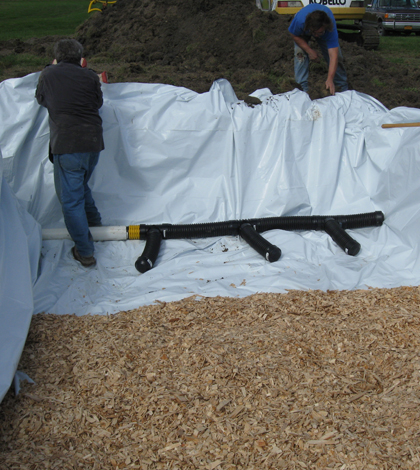Cornell scientists: Wood chip filters could be key to cutting nitrate from runoff

Filling a bioreactor with wood chips on a vegetable farm in Freeville, N.Y. (Credit: William Pluer and Larry Geohring)
Reducing nitrate-rich farm runoff is vitally important to the health of U.S. waterways. The runoff makes its way downstream, contributing to algal blooms and poor water quality. It’s a complex problem and has been studied extensively, but there might be a simple solution: wood chips.
A team at Cornell University is looking into the idea of feeding agricultural runoff through boxes of wood chips that decompose over time through the action of nitrate-consuming bacteria. If findings reveal substantial nitrate reductions in runoff, a new standard method for nitrate reduction could be developed.
The researchers, including Larry Geohring, Tammo Steenhuis and Todd Walter, have set up a total of six sealed drain collection boxes on two dairy farms and one vegetable farm along the Susquehanna River. Placed at the outlets of tile drains, the boxes – or “bioreactors” as the team calls them – contain wood chips that decompose as water drains through, removing the nutrients from the water before it’s released.
The boxes are 6 feet deep and about 10 square feet per side. Samples of water going in and out are collected in bottles every few weeks and nitrate levels are assessed using ion chromatography.
“We have six reactors in place and we’re seeing an 80 percent reduction in nitrates,” said Walter, associate professor of hydrology. “We’re getting higher reductions for places using animal fertilizer versus chemical fertilizer.”
The team didn’t expect such a dramatic drop. “We didn’t anticipate it to work so quickly,” said Walter.
Part of the project is to see if the bioreactors will reduce nitrates in runoff. “But if you react it only partially, you make nitrogen oxide,” said Walter. “We’re hoping it reduces to nitrogen gas, which is pretty inert.” So there’s potential for nitrates to be changed into a gas that safely constitutes more than 70 percent of the air in the atmosphere.

The outlet control structure on a bioreactor in Freevillie, N.Y. (Credit: William Pluer and Larry Geohring)
The team is also using biochar (incinerated plant matter) to try and bring down phosphorus concentrations. Past research has shown that liquid carbon can reduce nitrate and phosphorus levels. Biochar is an improvement because the liquid carbon wouldn’t stay in place long enough to react with either contaminant, instead flowing out with drainage water.
“Biochar has a very reactive surface. Chemicals ares really prone to binding to biochar,” said Walter. Of the six bioreactors the team has set up, half contain biochar, which will provide for comparing the reduction performance of wood chips by themselves or in combination with biochar.
The study should run for a full year, ending up sometime in summer 2014. As the project moves forward, data are being shared with farmers who want to know more about reducing runoff.
“We hope this becomes part of the NRCS (Natural Resources Conservation Service) best practices,” said Walter.
The NRCS is an arm of the U.S. Department of Agriculture that defines management practices to protect land quality and reduce erosion, overseeing programs that help farmers manage their land responsibly. The study’s findings should provide a basis for improved runoff management, and Walter says implementing them should not cost the average farmer a great deal.
“The main expense is getting a backhoe or excavator for a day,” said Walter. “The approach works in the Northeast, or anywhere. The Midwest has a lot of tile drains where reactors could be plugged in.”




0 comments